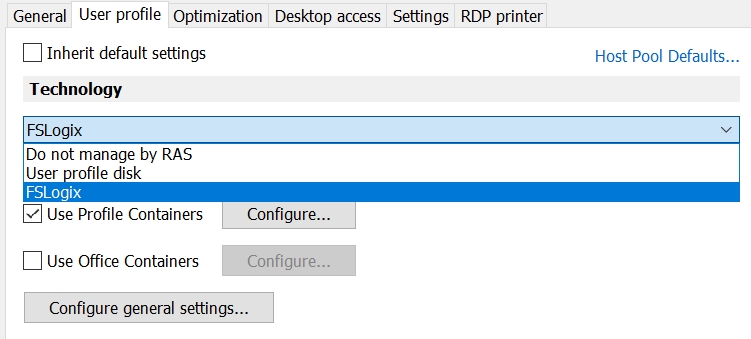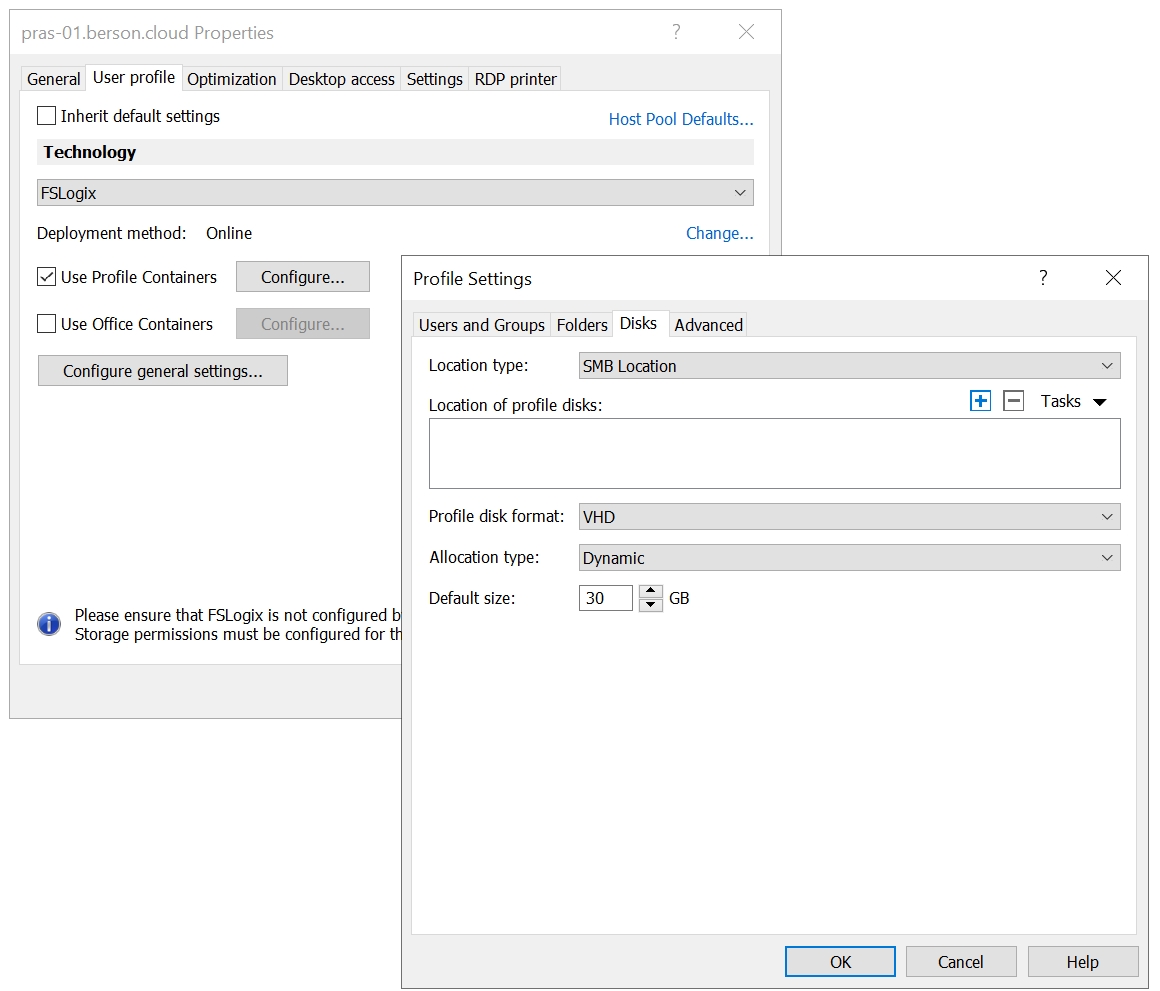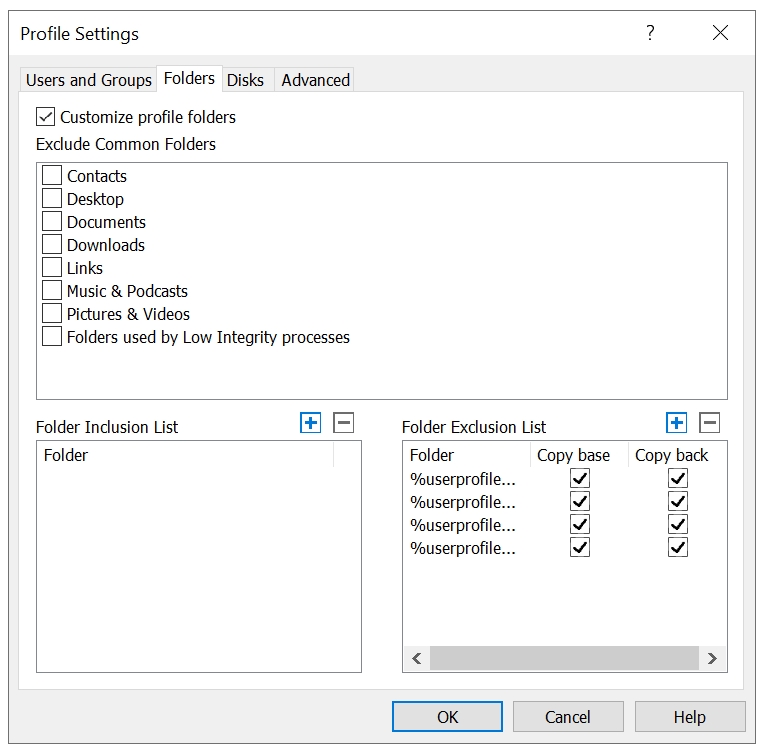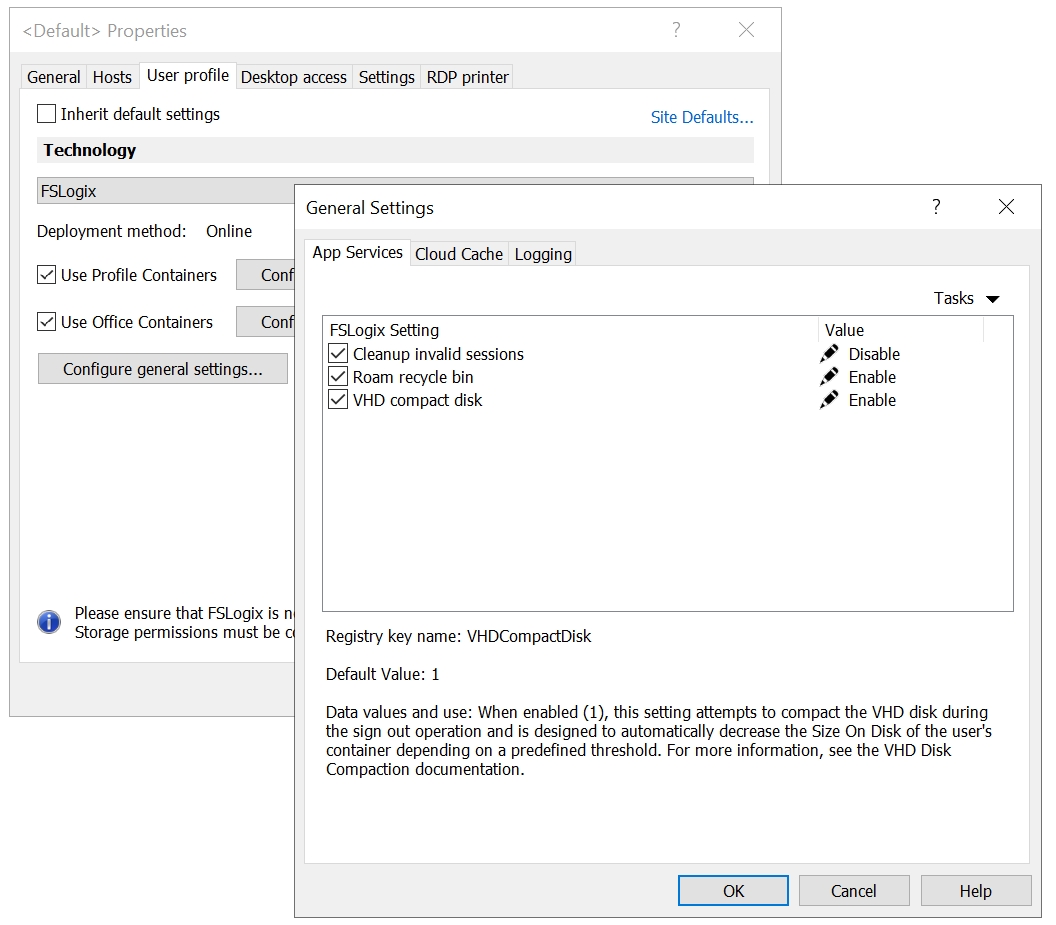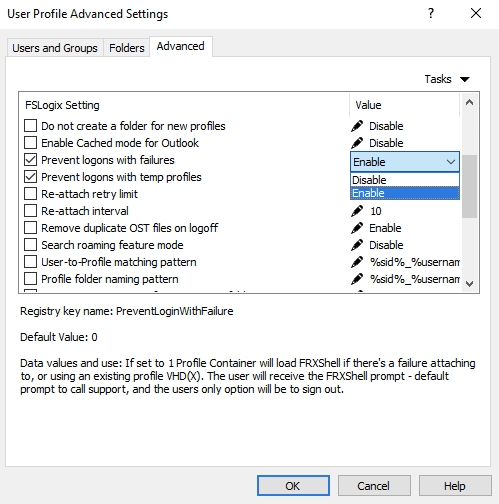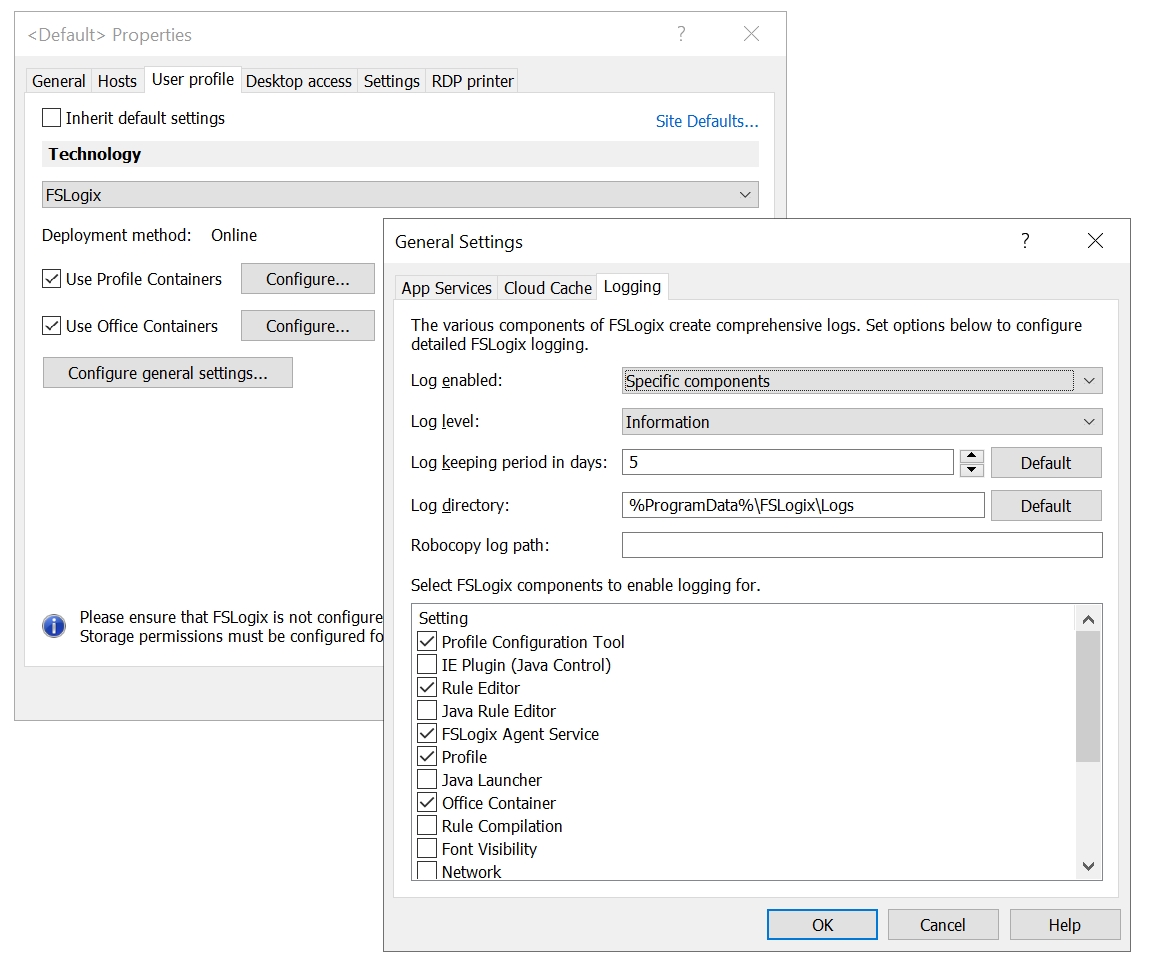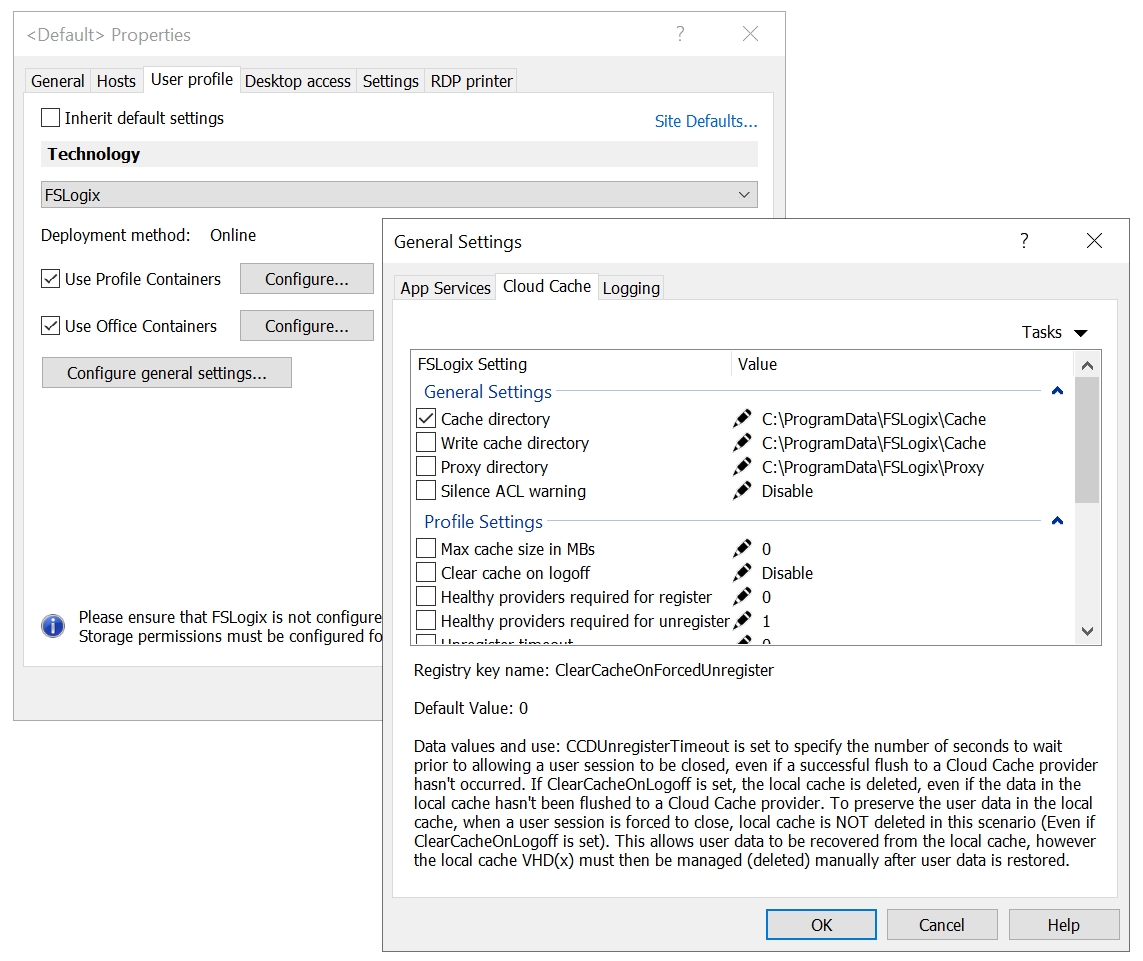
Loading...
Loading...
Loading...
Loading...
Loading...
Loading...
Loading...
Loading...
Loading...
Loading...
Loading...
Loading...
Loading...
Loading...
Note: at the time of writing, Parallels RAS Management Portal can configure FSLogix Profile Containers for RD Session Hosts only. For other host types, please use the desktop-based Parallels RAS Console.
FSLogix can be configured on the User profile tab. To reach it follow the steps below.
RD Session Hosts:
In Parallels RAS Console, go to Farm > RD Session Hosts > Host pools.
Right-click the Host pool you need and select Properties.
Select the User profile tab.
In Parallels RAS Management Portal, go to Infrastructure > Host pools.
Select the host pool you need.
Go to Properties > User Profile.
VDI:
In Parallels RAS Console, go to Farm > VDI > Host pools tab.
Right-click the host pool you need and select Properties.
Select the User profile tab.
Azure Virtual Desktop:
In Parallels RAS Console, go to Farm > Azure Virtual Desktop > Host Pools tab.
Right-click the host pool that you need and select Properties.
Select the User Profile tab.
The most recent instructions are also available in Parallels RAS Administrator's Guide: https://download.parallels.com/ras/v19/docs/en_US/Parallels-RAS-19-Administrators-Guide.pdf
FSLogix configuration can either be enforced on an individual server or on multiple servers at once using host pools Group Defaults. For testing purposes, when configuring RDSH, it is recommended to test FSLogix configuration on a single machine before applying the settings to all machines.
To enable FSLogix on a single machine:
On the User Profile tab, clear the Inherit default settings checkbox.
In the Technology the drop-down menu, select FSLogix.
FSLogix Profile Containers settings are described below.
Deployment method: Here you need to select a method that Parallels RAS will use to install FSLogix agent on individual hosts. You can select from one of the following:
Install manually: Select this option if you want to install FSLogix agent on every host yourself. If this option is selected, Parallels RAS will not attempt to install FSLogix on a host.
Install online: The default method. This option installs FSLogix agent on session hosts from the Internet. Select one of the Parallels supported FSLogix versions from the drop-down list or select Custom URL and specify a download URL. Click the Detect latest button to automatically obtain a URL of the latest FSLogix version.
Install from a network share: Select this option if you have the FSLogix installation files on a network share and specify its location.
Push from RAS Connection Broker: This option allows you to upload the FSLogix installation archive to the RAS Connection Broker server. When you enable FSLogix on a session host, it will be push installed on the host from the RAS Connection Broker server.
To configure the FSLogix profile container or Office Container disk details, select User Profile Containers or Use Office Containers and open the Disks tab.
Location type: Select a location type for profile disks (SMB Location or Cloud Cache).
Location of profile disks: Specify one or more locations per FSLogix requirements (https://docs.microsoft.com/en-us/fslogix/profile-container-configuration-reference). SMB Location stands for VHDLocations, Cloud Cache – CCDLocations.
Note: Ensure that the proper storage permissions are set for the location as described in section Required storage permissions.
Example SMB location:
The value is constructed as:
<\Location1\Folder1>
Example Cloud Cache based on an SMB location: :
The value is constructed as:
type=smb,connectionString=<\Location1\Folder1>
Example Cloud Cache based on Azure Page Blobs location:
The value is constructed as:
type=azure,connectionString=”|fslogix/ConnectionString|”
Note that ‘fslogix/ConnectionString’ is a reference to a system stored in Windows Credential Manager. That system credential contains the full string pointing to the Azure Page Blob. It is advised to use Windows Credential Manager because otherwise you would expose sensitive Azure credentials to any user who has access to the session host registry. The full string is constructed as:
"DefaultEndpointsProtocol=https;AccountName=<accountname>;AccountKey=<Accountkey>;EndpointSuffix=core.windows.net"
This string can be retrieved from your storage account in Azure. Inside the Azure Portal, navigate to the storage account, click Access Keys, and copy the contents of Connection String as shown below.
To create, delete, and view system credentials from Windows Credential Manager, use the frx.exe command which is a part of FSLogix. For example, to create a new system credential, run the following command:
C:\Program Files\FSLogix\Apps\frx.exe add-secure-key -key ConnectionString -value "DefaultEndpointsProtocol=https;AccountName=<accountname>;AccountKey=<Accountkey>;EndpointSuffix=core.windows.net" creates a key called ‘ConnectionString’, matching the previous example. Note that adding ‘fslogix/’ is not required as this is added automatically by frx.exe. For more information on working with Credentials Manager see https://learn.microsoft.com/en-us/fslogix/configure-cloud-cache-tutorial#protect-azure-key-with-credential-manager.
Profile disk format: Select from VHD or VHDX according to your requirements. VHDX is a newer format and has more features.
Allocation type: Select Dynamic or Full. This setting is used in conjunction with the Default size setting (see below) to manage the size of a profile. Dynamic causes the profile container to use the minimum space on disk, regardless of the allocated default size. As a user profile is filled with more data, the amount of data on the disk will grow to the size specified in the Default size but will never exceed it.
Default size: Specifies the size of newly created VHD(X) in megabytes.
Users and Groups: This tab allows specifying include and exclude user and group lists. By default, “Everyone” is added to the User inclusion list. If you want some user profiles to remain local, you can add those users to the exclude list. Users and groups can exist in both lists, but the exclude list takes priority in this case.
Folders: Here you may specify include and exclude lists for folders. Select from common folders or specify your own. Please note that folders must reside in the user profile path.
Advanced: This tab allows modifying advanced FSLogix Profile Container and Office Container settings. To modify a setting, highlight it and click the Edit button (alternatively, you may use the Tasks > Edit option from drop down menu in the upper right corner of the tab). Things to consider:
By default, all settings are disabled.
To enable a setting, select the checkbox in front of its name.
A description for each setting is provided in the same window.
Note: Please ensure that you’re familiar with the settings before modifying them. For further information regarding FSLogix Profile Containers configurations, see https://learn.microsoft.com/en-us/fslogix/reference-configuration-settings.
The Advanced tab of Profile Container settings allows you to change settings that are specific to Profile Container.
The Advanced tab of Office (ODFC) Container settings allows you to change settings that are specific to Office Container.
Configure general App Services settings
There are 3 settings that apply to both Profile and the Office Container.
To configure App Services settings:
Open the User profile tab.
Click Configure general settings and select the App Services tab.
Cleanup Invalid Sessions: In cases where a user's session terminates abruptly, the VHD(X) mounted for the user's profile isn't properly detached and the user's next sign-in may not successfully attach their VHD(X) container. Enable this setting, and FSLogix will attempts to clean up these invalid sessions and allow a successful sign-in.
Roam Recycle Bin: When enabled, this setting creates a redirection for the user's specific Recycle Bin into the VHD(X) container. This allows the user to restore items regardless of the machine from where they were deleted.
VHD Compact Disk: When enabled, this setting attempts to compact the VHD disk during the sign-out operation. It is designed to automatically reduce the?size of the container file depending on a predefined threshold.
When you enable FSLogix for a new host while running the wizard, no additional steps are necessary. On wizard completion, the host is rebooted and is added to the active load balancing. An existing host must be rebooted manually using the Tasks > Tools > Reboot menu option.
To reboot an existing host with Parallels RAS Management Portal:
Go to Infrastructure.
Select the RD Session Host that you need.
Go to Overview > expand Control > Reboot.
Back up your existing profiles. It is highly unlikely that profile data can be lost or corrupted, but it is best practice to have a valid backup prior to any change in the profile configuration.
Turn off the GPO configuration of FSLogix Profile Containers. This step is important because you cannot have both GPO and Parallels RAS management of FSLogix profiles enabled at the same time.
Before configuring FSLogix profiles for a server in a RAS Farm, make sure there are no user sessions running on the server. As a suggestion, you can make the transition in a maintenance window out of working hours.
To configure user profile from the RAS Console:
Follow the instruction from section New FSLogix deployment via Parallels RAS and open the User Profile tab.
Specify the following:
The location type. In the Location of profile disks list box, specify your existing SMB or Cloud Cache locations where your FSLogix profiles are stored.
Profile disk format, allocation type, and default size of the profile.
Click the Additional Settings button to configure FSLogix per your requirements, including:
User exclusions
Folder exclusions
FSLogix settings (https://docs.microsoft.com/en-us/fslogix/profile-container-configuration-reference)
To configure profiles in Parallels RAS Management Portal:
Go to Infrastructure > RD Sessions Hosts.
Select the RD Session Host that you need.
Go to Properties > User Profile.
Specify the settings as described above for the Parallels RAS Console.
In this section, we describe how to configure existing FSLogix Profile Containers to be managed by Parallels RAS. FSLogix Profile Container configuration defines how and where the profile is redirected. Normally, you configure profiles through registry settings and GPO. Parallels RAS gives you the ability to configure profiles from the Parallels RAS Console or RAS Management Portal without using external tools.
For existing configuration, please note the following:
There is no need to change the existing profiles themselves as they will stay the same.
You can keep using the existing FSLogix Profile Container locations (SMB or Cloud Cache).
For information about migrating to FSLogix Profile Container, visit https://www.christiaanbrinkhoff.com/2020/02/14/youtube-how-to-migrate-from-upd-to-fslogix-profile-container-profiles-to-windows-virtual-desktop/.
Note: FSLogix Profile Container may not support all functionality of the format it was converted from.
Pros:
Less impact on writes caches such as I/O capabilities.
Faster logon/logoff times in comparison to Cloud Cache.
Cons:
Manual replication requirements and an active-passive methodology only.
Lack of seamless failover.
Can only consume SMB locations. Azure Files can be used as well. For more information, see: https://www.christiaanbrinkhoff.com/2020/03/01/learn-here-how-to-configure-azure-files-with-active-directory-ad-authentication-for-fslogix-profile-container-and-msix-app-attach/.
The following are general best practices for using FSLogix profile containers.
For optimal performance, the storage solution and the FSLogix profile containers should exist in the same data -center location.
Exclude the VHD(X) files for profile containers from antivirus scanning to avoid performance bottlenecks.
In the case of AVD, Microsoft recommends using a separate profile container per host pool while having two active sessions.
For more information, see https://docs.microsoft.com/en-us/azure/architecture/example-scenario/wvd/windows-virtual-desktop-fslogix.
In addition to SMB locations, FSLogix introduced the Cloud Cache technology (https://docs.microsoft.com/en-us/fslogix/cloud-cache-resiliency-availability-cncpt. Please review the list of advantages and disadvantages of each approach before d)eciding on which type of locations to use.
Cloud Cache is useful for creating profile high availability in physical environments. The recommended configuration when using Cloud Cache for physical machines that may go offline (for example, a notebook computer) is:
CCDLocations should be configured so that the first Cloud Cache Provider is placed on the local drive.
ClearCacheOnLogoff would generally be set to 1, to avoid eventually having two full copies of the profile on the local machine.
For more detailed information, see article “Cloud Cache to create resiliency and availability” at https://docs.microsoft.com/en-us/fslogix/cloud-cache-resiliency-availability-cncpt.
Cloud Cache is a technology that allows FSLogix Profile Container data to be stored in multiple locations at once, including traditional on-premises SMB shares and public cloud storage providers, and to enable real time, 'active-active' redundancy for Profile Container. Cloud Cache also uses a local cache of the profile disk to service all reads from a redirected profile after the first read. Cloud Cache can protect users from short-term loss of connectivity to remote profile containers. When using Cloud Cache, CCDLocations replaces VHDLocations. CCDLocations and VHDLocations cannot be used at the same time. Note that storing profiles in multiple locations at once generates more Azure consumption. Azure Blob storage specifically can be expensive in certain use cases. In general, always use the Azure calculator to calculate Azure consumption costs up front.
Pros:
Seamless failover should the loss of a single storage location occur.
Real-time, active-active redundancy for Profile Container .
Native cloud storage such as Azure Blob, can be utilized.
Useful if you have latency issues between the location of storage and location of workloads.
Cons:
Logon and logoff delays that impact the user experience. This delay is variable based on many factors such as the location of the container in relation to the location of workloads.
A less mature solution.
I/O capabilities must be considered as it affects user experience. See best practices for Cloud Cache below.
Parallels RAS allows you to configure Cloud Cache from within Parallels RAS Console.
To configure Cloud Cache:
Open the User profile tab.
Click Configure general settings and select the Cloud Cache tab.
From here you can configure all advanced settings related to Cloud Cache.
FSLogix provides options to enable advanced logging for all of the FSLogix components. Parallels RAS allows you to configure advanced logging from within RAS Console.
To configure advanced logging:
Open the User profile tab.
Click Configure general settings and select the Logging tab.
From here you can configure all advanced settings related to logging. Specify for which components you want to enable logging, and provide a log level, retention period, and log directory.

Microsoft allows moving current Profile Container implementations to Cloud Cache. To start using Cloud Cache, replace the VHDLocations setting with CCDLocations. CCDLocations and VHDLocations may not be used in the same implementation simultaneously.
A Cloud Cache Provider contains both the profile container and associated metadata, while a traditional VHDLocation contains only the profile container. If Cloud Cache points to profile containers without metadata, the metadata will be created. When the metadata is added, the Profile Container location is converted to a Cloud Cache provider.
If a user has profile containers in more than one CCDLocation, the profile container listed first in CCDLocations will be updated to a Cloud Cache provider. All other profile containers in the same CCDLocations string will be deleted and replaced from the first Cloud Cache Provider.
There's no mechanism to merge multiple profile containers into a single profile.
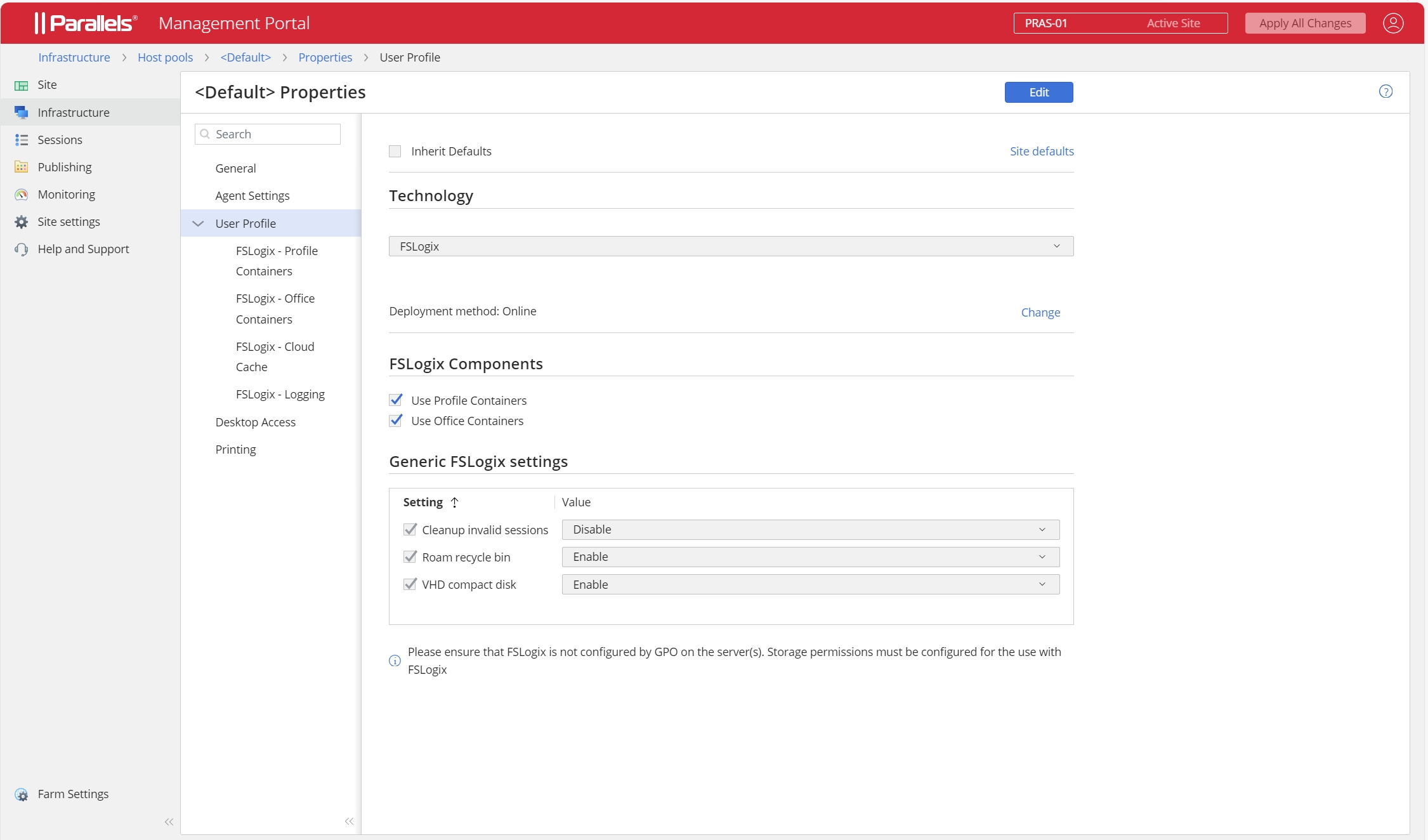
To achieve high availability for FSLogix Profile Container on-premises, Parallels recommends using multiple SMB locations with a single VHD path and Distributed File System Namespace in front of one or many SMB locations (note that only one SMB location can be active at one time) as active-passive HA. DFSR is applicable to NTFS-based SMB locations, but a third-party synchronization tool, such as https://bvckup2.com/kb/beyond-robocopy, is required for ReFS.
Multiple locations can be specified from the User Profile tab by clicking on the [+] button.
For FSLogix Profile Container in the cloud (e.g. Microsoft Azure), multiple storage solutions are available, with the recommended ones being Azure Files and Azure NetApp Files. Additional best practices apply, such as setting up the storage solution in the same datacenter location and excluding the VHD(X) files for Profile Container from antivirus scanning. For more information about FSLogix Profile Container and Azure deployment options, see https://docs.microsoft.com/en-us/azure/virtual-desktop/create-fslogix-profile-container.
More information on DFS and DFSR can be found at https://technet.microsoft.com/enus/library/jj127250.aspx.
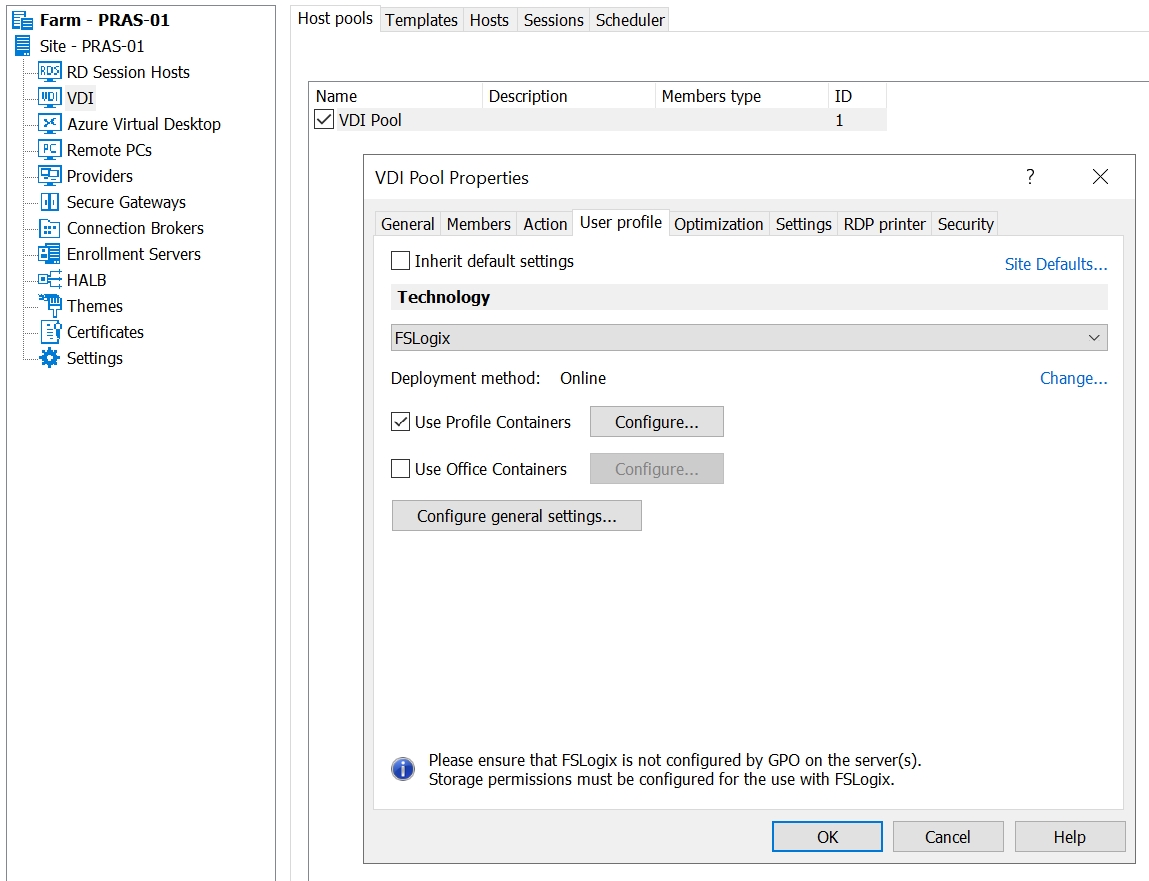

Cloud Cache technology allows storing multiple copies (per Microsoft, the practical limit is 4) of Profile Containers on SMB file shares and keeping its data in sync without the need to deploy complex replication infrastructure. Note though that logon and logoff delays may impact the user experience.
Examples of usage:
Keeping copies of profiles in several storage locations (disaster recovery data center).
Replicating data to the more cost-effective storage.
Migrating from one storage location to another.
To configure multiple Cloud Cache locations (corresponds to CCDLocations setting), simply add them using the [+] button on the User Profile tab.
Profile Container will read data from a provider if the data needed does not already exist in the Local Cache file. When configuring Cloud Cache locations, the order Providers are listed defines the order Profile Container uses them for reading. If the first path specified is unavailable, then Profile Container will attempt to read from the second Provider and so on.
Cloud Cache will always write to all Providers specified in CCDLocations, unless a specified Provider isn't available.
Because the Local Cache file will service most I/O requests, the performance of the Local Cache file will define the user experience. It is critical that the storage used for the Local Cache file is high-performing and highly available. It is also suggested that any storage used for the local cache file should be a physically attached storage or have reliability and performance characteristics that meet or exceed high-performing physically attached storage. When using Cloud Cache, FSLogix profiles can be stored on Azure Files as well as directly on Azure Page Blobs. For Azure Page Blobs, it is important to secure sensitive Azure credentials by using Credential Manager. This is explained in Chapter 3.
